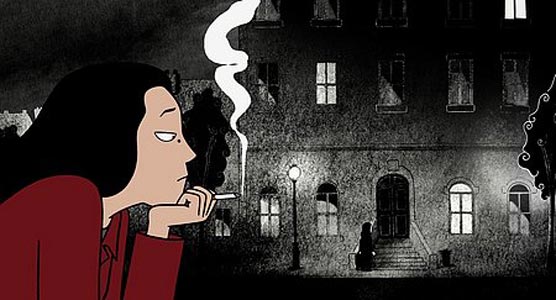|
Click here to return to the main site. Marjane Satrapi (Writer / Director) - Persepolis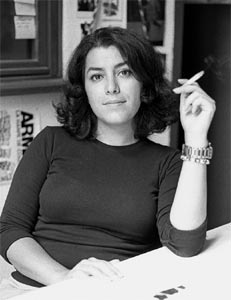 Marjane Satrapi was born in 1969. She grew up in Tehran where she attended the Lycée Français (French high school). She then studied in Vienna before she relocated to France in 1994. In Paris, through fellow comic book artists, she was introduced into the Atelier des Vosges, an artist studio which gathered major, contemporary comic book artists. In her first graphic novel, Persepolis 1, published by L'Association in November 2000, Marjane told the story of the first ten years of her life until the overthrow of the Shah regime and the outbreak of the Iraq-Iran war. Persepolis 2, 3 and 4 soon followed. Since then, she has published Embroidery (Broderies) and Chicken with Plums (Poulet aux Prunes). ReviewGraveyard caught up with Satrapi as Persepolis was released on DVD... ReviewGraveyard: Did you adapt your graphic novel for the screen because you felt you weren't finished with this story?
To be completely honest, it had been four years since I'd written and drawn Persepolis, I felt the work was finished. It was when I started talking with Vincent about the film project that I realised I not only had the opportunity to work with him, but also the possibility to experience something completely new. After having written graphic novels, children's books, comic strips for newspapers, murals, etc, I felt that I'd reached a transition period. I didn't want to make a film all by myself and I felt if I was going to do it with anyone, it should be with Vincent and Vincent alone. He was game for it, and as excited as I was by the challenge. I thought we'd have fun... Sometimes, it's the little things that lead to decisions. As I already knew (Producer) Marc-Antoine Robert, we began working together. That was it. RG: Did you know from the beginning that it was going be an animated feature
The novels have been a worldwide success because the drawings are abstract, black-and-white. I think this helped everybody to relate to it, whether in China, Israel, Chile, or Korea, it's a universal story. Persepolis has dreamlike moments, the drawings help us to maintain cohesion and consistency, and the black-and-white (I'm always afraid colour may turn out to be vulgar) also helped in this respect, as did the abstraction of the setting and location. Vincent and I thought the challenge was all the more interesting for this and exciting from an artistic, aesthetic standpoint. RG: What drove you to ask Vincent to share your studio six years ago? MS: At the time I hadn't met him. I'd seen his drawings at a friend's place and thought to myself “you'd have to cut this guy's fingers off to stop him from drawing!”, his work was just fantastic. There is something totally off-the-wall and over-the-top about it, and yet it also has dignity and decency. I'd also seen two short films he'd made with Cizo [Lyonnel Mathieu]: O Boy What Nice Legs and Raging Blues which I liked very much. RG: How do you complement each other?
MS: When we shared the same studio, we did drawings together. We have different styles but they match so well. We come from totally different countries, cultures and backgrounds, yet we've always been on the same wavelength. You could say that together we shattered the notion of "the culture clash". I'm an outgoing kind of person, he's rather introverted, but when it comes to drawing, working together, it's the other way around. When we worked like madmen for three years, we never had a single row, although we were always honest with each other. RG: Did you have difficulty choosing the material from the four novels you wanted to keep in the movie? MS: When I was writing the books, I had to remember sixteen years of my life, including things I definitely wanted to forget. It was a very painful process. I dreaded starting the script, and couldn't have done it on my own. The hardest part was the beginning, and distancing myself from the existing narrative. We had to start from scratch, to create something altogether different but with the same material. It's a one-of-a-kind piece. There was no point filming a sequence of panels. People generally assume that a graphic novel is like a movie storyboard, which of course is not the case. With graphic novels, the relationship between the writer and reader is participatory. In film, the audience is passive. It involves motion, sound, music, so therefore the narrative's design and content is very different. RG: Did you both agree on the look of the film from the very start? MS: Yes, I guess it could be defined as "stylised realism," because we wanted the drawing to be completely life-like, not like a cartoon. Therefore, unlike a cartoon, we didn't have that much of a margin in terms of facial expressions and movement. This was the message which I was determined to convey to designers and animators.
In both schools, you find the kind of hope in people who went through the war and experienced great despair. I am myself a post-war person having lived through the 8 year war between Iraq and Iran. The film is a combination of sorts; of German expressionism and Italian neo-realism. It features very down-to-earth, realistic scenes, and a highly design-oriented approach, with images sometimes bordering on the abstract. We were also influenced by elements of movies we both loved, like the fast pace of Scorsese's Goodfellas. RG: When it came to the filmmaking, how did you split the work between you, Vincent and artistic director Marc Jousset?
I wrote the plot and Vincent and I wrote and discussed the shooting of the script. Vincent then took care of the production design, the actual shooting, the props, the characters, and what was going on within each scene. However we all had a say on every stage of the filmmaking. Now I can barely tell where his work begins and where mine ends and visa versa. We complemented each other so to speak. RG: This is an animated film with a lot of characters… MS: 600 different characters altogether! It's unusual to have so many! I drew them all, their fronts and their profiles. Afterwards, the designers and animators drew them from every angle developing their facial expressions and motions. To help them out, I was filmed acting out the scenes. It was the key to keeping the emotion intact, and finding the right balance between sobriety and fantasy. I also had the dreadful job of choreographing the "Eye of the Tiger" scene… RG: Was it hard for you to see other designers reinterpret your drawing and also drawing your face constantly?
Unlike Vincent, I had always worked on my own. I even had my own corner in the studio, so you can imagine how I felt when I saw my face everywhere, In small, medium and large, as a little girl, a teenager, a young girl, a grown-up, front, back, profile, laughing, vomiting, crying etc. It was just unbearable! I had to say to myself "it's just a character." It was the same for the other characters because their stories are also real. My grandmother of course, actually existed and lived and died, as had my uncle. I couldn't let emotion get in the way, or else it would have become intolerable for everyone. If they'd seen me with tears in my eyes, they wouldn't have been able to continue with their work. We needed them to feel free so that they could do their best, so I had no choice but to talk about myself and the people in my life as fictional characters: "Marjane does this, her grandmother's like that…" otherwise it would have been impossible. This doesn't mean that at times I wasn't overwhelmed by emotion, (notably the time when the designers were drawing my parents). It was only after the script was written that this story became fiction and went public. It wasn't exactly me anymore, and yet, paradoxically, it was still me... RG: Why did you choose Chiara Mastroianni for "your" voice?
The first name we thought of was Danielle Darrieux's as my grandmother. She was the only one who could do it justice; she's funny, intelligent and full of wit and sass. She loves to have fun and doesn't shy away from absurd situations. I'll always treasure the time we spent recording her voice. I dreamed of Catherine Deneuve for my mother's voice. Back in Iran, the two most famous French actors at the time were Catherine Deneuve and Alain Delon. She was perfect for the part. When she was Chief Editor of Vogue, she picked twenty artists to work on the issue, including me. I was so proud. When I asked her to lend her voice, she said yes right away. I must say I was impressed when I directed and played opposite her. At some point in the script, I was supposed to say: "Women like you - I just want to f*ck them against the wall and throw them in the trash!" Fortunately it became easier after gulping down a few glasses of cognac!
RG: What was the most memorable moment of the whole experience? MS: The first screening for the whole team in a theatre on the Champs-Elysées. At the end, I was crying, and so was the whole audience. RG: Iran is still in the headlines today. Even though you want the film to be universal, you can't stop people from seeing it in this light...
However, if western audiences end up considering Iranians as human beings just like the rest of us, and not as abstract notions like - "Islamic fundamentalists", "terrorists", or the “Axis of Evil”, then I'll feel like I've done something. Don't forget that the first victims of fundamentalism are the Iranians themselves. RG: Do you miss Iran? MS: Of course. It's my homeland and always will be. If I were a man, I'd say Iran is my mother and France is my wife. Obviously, I can't forget all those years when I'd wake up with a view of an 18,700-foot high, snow-covered mountain that dominated Tehran and my life... It's hard to think that I'll never be able to see it anymore. I miss it. As long as you're alive you can protest and shout, yet laughter is the most subversive weapon of all. RG: Thank you for your time.
Persepolis is released on Blu-ray and DVD from Optimum Home Entertainment from Click here to buy Persepolis on Blu-ray for £17.98 (RRP: £24.99) Click here to buy Persepolis on DVD for £10.98 (RRP: £17.99) Return to... |
|---|
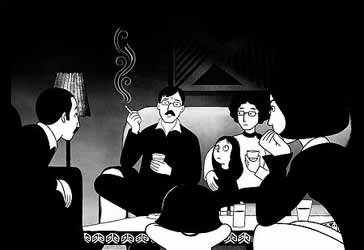 Marjane Satrapi: I suppose it's my collaboration with Vincent [Paronnaud] which made things possible. When the graphic novels were first published, they had immediate success and I got several offers to adapt Persepolis, especially when the books were published in the US. I even got offered projects like a Beverly Hills 90210-type TV show and a movie featuring Jennifer Lopez as my mother and Brad Pitt as my father - things like that! It was just crazy.
Marjane Satrapi: I suppose it's my collaboration with Vincent [Paronnaud] which made things possible. When the graphic novels were first published, they had immediate success and I got several offers to adapt Persepolis, especially when the books were published in the US. I even got offered projects like a Beverly Hills 90210-type TV show and a movie featuring Jennifer Lopez as my mother and Brad Pitt as my father - things like that! It was just crazy.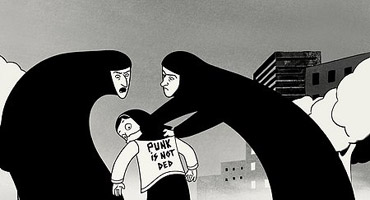 MS: Yes, I think we'd have lost the universal appeal of the storyline. With live-action, it would have turned into a story of people living in a distant land who don't look like us. At best, it would have been an exotic story, and at worst, a "Third-World" story.
MS: Yes, I think we'd have lost the universal appeal of the storyline. With live-action, it would have turned into a story of people living in a distant land who don't look like us. At best, it would have been an exotic story, and at worst, a "Third-World" story.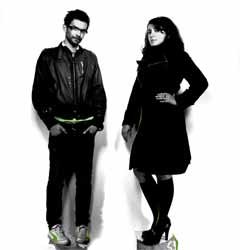
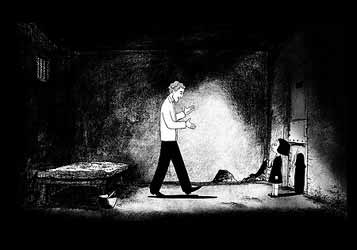 I've always been obsessed with Italian neo-realism and German expressionism and soon understood why, as they're post-war film schools. In post-WWI Germany, the economy was so devastated that they couldn't afford to shoot films on location, and so they were shot in studios using mood and amazing geometrical shapes. In post-WWII Italy, the same happened, but things turned out the opposite - they shot films in the streets with unknown actors because they had no money.
I've always been obsessed with Italian neo-realism and German expressionism and soon understood why, as they're post-war film schools. In post-WWI Germany, the economy was so devastated that they couldn't afford to shoot films on location, and so they were shot in studios using mood and amazing geometrical shapes. In post-WWII Italy, the same happened, but things turned out the opposite - they shot films in the streets with unknown actors because they had no money.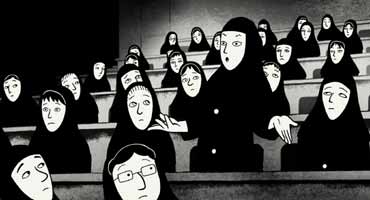 MS: We needed someone with an overview, someone who could control all stages of the filmmaking process. Vincent suggested Marc Jousset because he'd worked with him on Raging Blues. Marc was the only one who understood what we wanted to do.
MS: We needed someone with an overview, someone who could control all stages of the filmmaking process. Vincent suggested Marc Jousset because he'd worked with him on Raging Blues. Marc was the only one who understood what we wanted to do.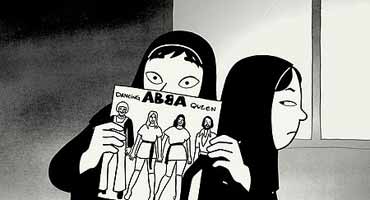 MS: It's a peculiar feeling. Your drawing is like your baby, and all of a sudden, it belongs to everybody! They didn't only reinterpret my drawings and my characters, but my face and life story.
MS: It's a peculiar feeling. Your drawing is like your baby, and all of a sudden, it belongs to everybody! They didn't only reinterpret my drawings and my characters, but my face and life story.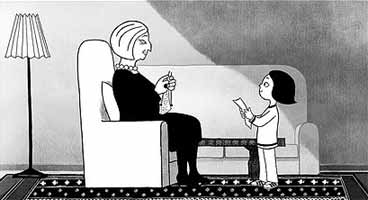 MS: We wanted to record the voices prior to the shoot so that the animation, motions and facial expressions could match the actors' dialogue and acting.
MS: We wanted to record the voices prior to the shoot so that the animation, motions and facial expressions could match the actors' dialogue and acting.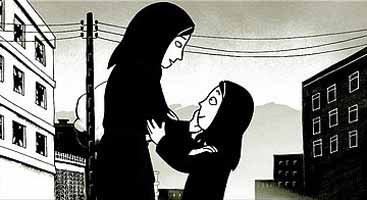 It was only after I picked Chiara that I realized I was adding a new chapter to a glamorous film mythology, as they'd already played mother and daughter on several occasions. As far as Chiara was concerned, she had actually heard about the film through her mother, and called me to do a voice test, after which we immediately connected. I loved her voice, her talent, her personality, her generosity. We worked hard and rehearsed for two months... She's a workaholic and perfectionist, like Vincent and myself. She followed every step of the filmmaking process and often dropped by the studio to visit us.
It was only after I picked Chiara that I realized I was adding a new chapter to a glamorous film mythology, as they'd already played mother and daughter on several occasions. As far as Chiara was concerned, she had actually heard about the film through her mother, and called me to do a voice test, after which we immediately connected. I loved her voice, her talent, her personality, her generosity. We worked hard and rehearsed for two months... She's a workaholic and perfectionist, like Vincent and myself. She followed every step of the filmmaking process and often dropped by the studio to visit us.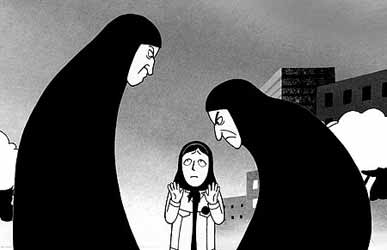 MS: True. Although in my eyes the most exotic section takes place in Vienna. The film is not judgemental, it doesn't say, "this is right and that is wrong" it just shows that the situation has many layers. This isn't a politically oriented film with a message to sell. It is first and foremost a film about my love for my family.
MS: True. Although in my eyes the most exotic section takes place in Vienna. The film is not judgemental, it doesn't say, "this is right and that is wrong" it just shows that the situation has many layers. This isn't a politically oriented film with a message to sell. It is first and foremost a film about my love for my family.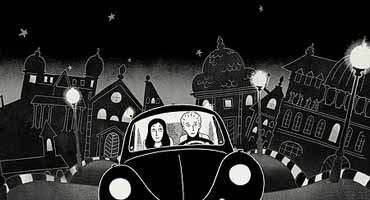 Then again, I have the life I wanted. I live in Paris, which is one of the most beautiful cities in the world, with the man I love, doing the job I like - plus, I get paid to do what I like to do. Out of respect for those who have stayed there, who share my ideas but cannot express them, I'd find it inappropriate and distasteful to be complaining. If I had given in to despair, everything would have been lost. So up until the last moment, I'll hold my head high and keep laughing because they won't get the best of me.
Then again, I have the life I wanted. I live in Paris, which is one of the most beautiful cities in the world, with the man I love, doing the job I like - plus, I get paid to do what I like to do. Out of respect for those who have stayed there, who share my ideas but cannot express them, I'd find it inappropriate and distasteful to be complaining. If I had given in to despair, everything would have been lost. So up until the last moment, I'll hold my head high and keep laughing because they won't get the best of me.